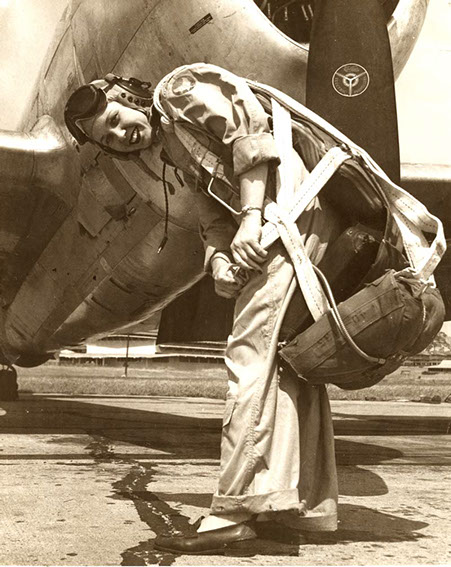
Airman 1st Class Susan McQueary
WASP pilot chronicles women's aviation contributions
Air Force Print News
Monday, March 18, 2002

Deanie Bishop Parrish first learned how to fly so she could "show all those good-looking male cadet instructors that girls could fly just as good as the boys."
Deanie is now trying to show the world the contributions that women pilots like her made more than 50 years ago.
Deanie and her daughter, Nancy Parrish, in conjunction with Baylor University in Waco, Texas, are documenting the history of Women Airforce Service Pilots and publishing it on the Internet to educate and inspire children.
"We want kids to know they can do anything they set their mind to," Deanie said. "I believe the WASP history is important to
preserve."
Deanie and Nancy travel around the country to record the stories of the remaining 600 WASP.
The WASP' journey began more than 50 years ago when 1,830 women traveled from all over the country to Avenger Field in Sweetwater, Texas, to learn to fly airplanes "the Army way." Once the women completed training, 1,074 of them were given their wings and became the first women in history to fly American
military aircraft. They were known as WASP.
The WASP were assigned to 120 air bases throughout the continental United States. The female pilots ferried aircraft and replaced male pilots so the men could fly in combat. The WASP flew every type of mission and every aircraft flown by Air Force male pilots except combat aircraft. However, the WASP were denied the same military benefits other servicewomen received during World War II, Deanie said.

Thirty-eight WASP lost their lives while serving their country as military pilots; however, unlike male pilots, their remains were returned in pine boxes at the family members' expense, Deanie said. These women were denied any benefits or honors. It was not until 1977, 33 years after the WASP disbanded, that the
women earned the honor of being named veterans.
"No one knew about the WASP. After we disbanded in 1944, the records were sealed and were marked classified," Deanie said. "The records were filed away in a government archive, so historians didn't even know the WASPs existed. We were called the 'best-kept secret of WWII.'"
Deanie's story began in 1941.
At the time, WASP trainees, at a minimum, had to have a private pilot's license before they could apply for training, Deanie said. To qualify, Deanie found an instructor in her hometown to give her lessons.
"I asked my instructor if he thought I'd make a good pilot. He told me that one day something would happen and I would know that I would," she said.
"On my first solo flight experience, as I pushed the stick forward, it came off in my hand. It wasn't connected. My first thought was that my instructor had done it on purpose," Deanie said. She realized she was going to stall, so she unbuckled her seat belt in the back seat, reached over the front seat and pushed
forward on the front stick to level off the aircraft.
"I climbed over into the front seat and saw a big red sign that said, 'do not fly solo from front seat.' I landed and knew my instructor was going to be mad," Deanie said. "I taxied to him and he walked away. Finally, he came over and asked what I was doing." Deanie pointed to the back seat and he saw the missing stick. "He told me, 'now you know you have the right stuff to be a pilot,'"
Deanie said. "The headlines read that I was lucky, but I knew better. From that day forward, I never had a doubt that I would be a good pilot."
After training at Avenger Field and becoming a WASP, Deanie was assigned to Greenville Army Air Base, Miss. (*as an engineering test pilot, and eventually to Tyndall AFB, Fl to fly twin engine bombers).
"My assignment was to fly B-26 (Marauder) as a tow target pilot," she said. "The B-26 had the largest number crashed in training of any aircraft, but it had the best combat record."
The tow target pilots would pull a target behind them while the gunners in a B-24 (Liberator) fired live ammunition at the target. "One day, a gunner shot my plane instead of the target. He put holes in the tail. I landed and was going to give him a piece of my mind," she said. "Instead, the *pilot and I fell in love and were married for 47 years."
For more WASP stories, visit www.wasp-wwii.org on the Internet.
Air Force Print News
*text added for accuracy








